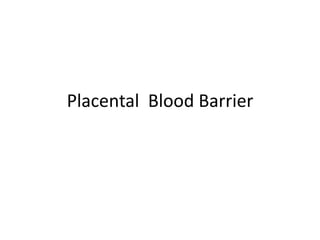
Placental Blood Barrier Functions and Mechanisms
- 2. Barrier Function • Fetal membrane has long been considered as a protective barrier to the fetus against noxious agents circulating in maternal blood. • In general , substances of higher molecular weight of > 500 daltons can not cross it, but there are some exceptions. Antibodies and antigens can cross the placental barrier in both direction by process of endo & exo cytosis. It is facilitated by pinocytosis . The race of drug transfer is increased in late pregnancy . Maternal viral, bacterial / protozoa infections can reach to fetus by crossing placental barrier . Similarly Any drug taken by women during pregnancy can cross the placental barrier in variable concentration and may have deleterious effect on fetus
- 5. Factors for Placental Transfer From Mother to Fetus A. SUBSTANCE Properties B. Maternal Properties 1, Molecular weight : Lower the MW 1. drug concentration in maternal more is transfer . blood – higher concentration –more is 2. Lipid solubility: Lipophilic substances diffusion. diffuse rapidly. 2. Uterine blood flow 3 . Ionization : non ionized form crosses 3. Concentration gredient on either lipid membrane freely. side of placental membrane. 4 . pH of bnlood favours ionization of many drugs ance delays diffusion . C. Placental properties 5. Pritein binding. 1. Lipid membrane of placenta 6. Spatial confugration enhances transfer of lipophilic substances. 2. Total surface area of placental membrene . 3. Functional integrity and thickness of placental barrier.
- 6. Mechanism Involved in placental Transfer • 1, Simple Diffusion: O2 & CO2 transfer take place by simple diffusion . Partial pressure gradient across placental barrier is the driving force. O2 supply to fetus is at the rate of 8ml / Kg / min and this is achieved with cord flood flow of 165-330 ml/ min .Excretion of urea, uric acid ,creatinin. • Facilitated Diffusion: ( transformer mediated using transporter protein in syncytotrophoblast., glucose with the help of transporter protein (GLUT I) , glucosr transfer increases more when maternal blood gluose is low. • Active Transfer: Against pressure
- 7. Mechanism involved in placental transfer -------- • Endocytosis: Invagination of cell membrane to form intra cellular vesicle which contain the extra cellular molecule.IgG immunoglobulin is taken up by endocytosis from maternal circulation • Exocytosis: Release of molecule with in the vesicle to the extra cellular space ---IgG immunoglobulin are transferred to fetus from placenta by exocytosis. • Leakage: break in placental membrane –Foetal RBC leak into maternal circulation.
- 8. Other functions of Placenta • Transfer of nutrients and waste priducts between mother and fetus ; Hence it atributes to –1. respiration, 2.excretion 3. nutrition. • Endocrine function-- placenta is an endocrine gland ., secrets –HCG , Steroids and peptide hormones. • Immunological function. • Blood Barrier.
- 9. Nutritive Function • Fetus obtains its nutrients from mother., when mother’s diet is inadequate , then only depletion of maternal tissue storage occur. Glucose The principle source of energy is transferred by Facilitated diffusion . There are transporter proteins (GLUT I) for this mode of diffusion. Glucose transfer to fetus is not linear ., it decreases when mother glucose concentration increases. Fetal blood glucose level is lower than that of mother indicating rapid utilization by fetus.
- 10. Nutritive function-- • Lipids Triglycerides and fatty acids are directly transferred to fetus in early pregnancy but probably synthesised by fetus itself in late pregnancy Essential fatty acids are transferred more then non essential fatty acids. Cholesterol is able to trtansfer directly. Thus lipids have dual origin. • Amino acids They are transferred by active transfer , energy requiring mechanism( ATPS Enzyme ). Amino acid concentration in fetal blood is more then maternal. IgG cross by endocytosis. Fetal proteins are synthesised from transferred amino acids ., their concentration is lower than mother. A
- 11. Nutritive Function---- • Water and Electrolytes Na ,K, Cl transferred by simple diffusion., Ca, P and Fe are transferred by active transfer with the help of transporter proteins against a concentration gradient. There concentration is higher than maternal. Water soluble vitamins are transferred rapidlyby active transport while fat soluble vitamins are transferred slowly.
- 12. Nutritive function--- • Hormones Insulin, steroids from adrenals ,thyroid, HCG, placental Lactogen, cross the placenta very slowly . Neither paratharmone nor calcitonin cross the placenta. Placenta also produce TSH and Growth Hormone.
- 13. Enzymatic Function • Numerous enzymes are mentioned in placenta ., few othem are--- • 1. Diamine oxidase which inactivates circulatory pressure amines. • 2. Oxytocinase --- neutralises the oxytocin . • Phospholipase A2-- synthesises archadonic acid precursor of PGs.
- 14. Immunological function • Fetus and placenta have partial pareantral antigens foreign to mother inspite of this , fetus is not rejected.Placenta offers immunological protection, • Placental hormones , protiens( SP1) early prgnancy factor (EPF) PAPP-A , Steroid , HCG have got some immuno suppressive effect. • Villous trophoblast do not express HLA Class 1or class 2 molecules . • There is shift of maternal response from cell mediated (T helper I ) to hormonal (T helper 2 ) immunity. • Decidual Natural Killer (NK) cells and extravascular trophoblast HLA class I molecules inter act ., the cytokinines just derived will regulate the invasion of extracellular trophoblast in spiral arteies , which are converted into low resistance, high conductance utero placental vessels.